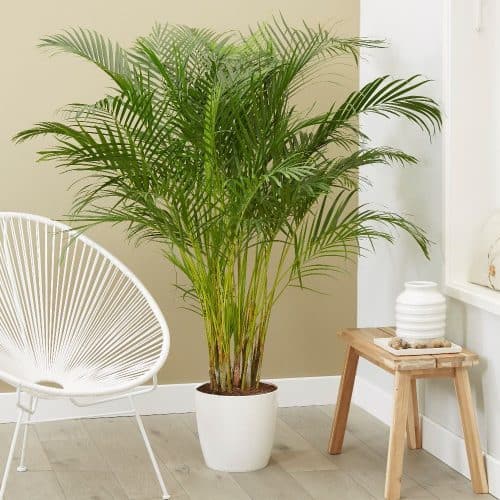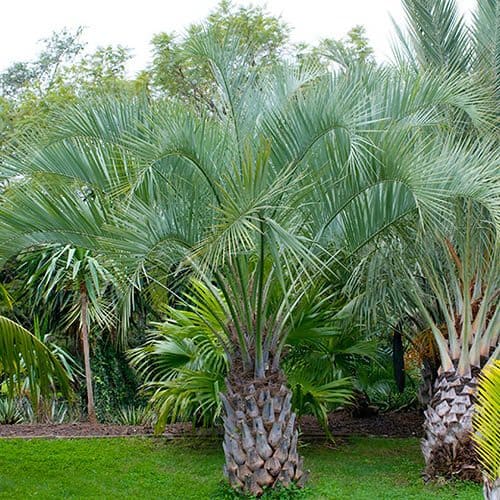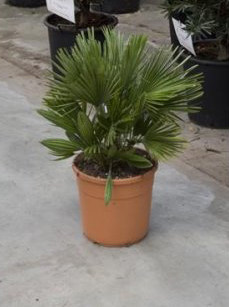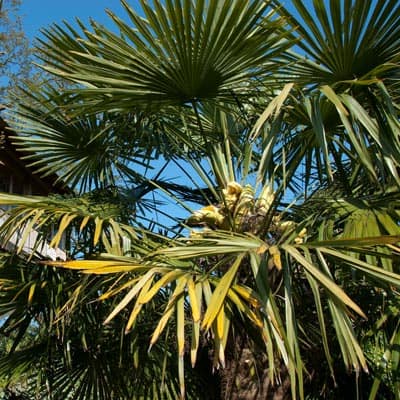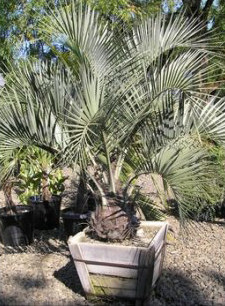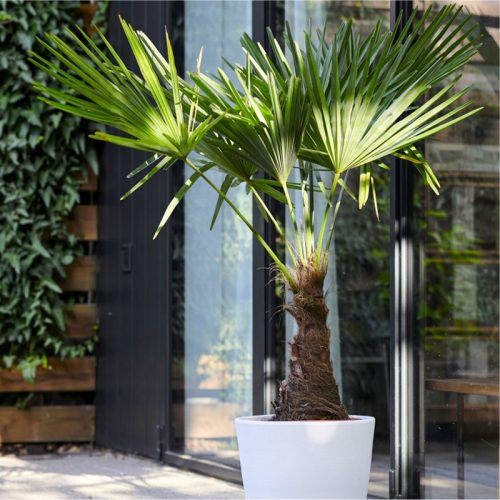Palms are integral to your exotic garden, and probably the main feature of your garden that screams ‘exotic garden’ (other than the now famous Musa Basjoo Banana). Palm trees have that distinctive silhouette that can’t be mistaken for anything else, and adds height and permanence in your garden that features through the winter too as a backbone. We have a list of the best Palm Trees below and the best place to buy palm trees for sale UK
All palms belong in the Arecaceae (previously Palmae) family, which are monocotyledonous plants. Palms are easy to recognise, but are often confused with other exotic plants such as hardy cordylines, yuccas, and sometimes even the humble Musa Basjoo. Cycads also look quite palm-like, so we have some information on Yuccas here.
IN THIS ARTICLE
Types of Palm Trees
The Best Palm Trees for the UK
Growing a palm tree in your garden in a British climate may seem foolhardy. Yet certain palm trees will survive and even thrive in our often damp and cold climate.
There’s nothing more tropical than seeing established palms growing in an ordinary urban English garden. However you need to choose the right tree as the combination of damp and winter cold can be fatal to many species.
Palms that Actually Grow Well in Britain
I have chosen three palms that are well suited to our climate, are easy to grow and widely available. I have grown them for years and they have a proven track record going back many decades.
The tallest palm you will probably see in someone’s garden is a Trachycarpus which is a type of fan palm. There are now several species available to buy in the UK of which the most widely available most hardy proven is fortunei and wagnerianus.
The 3 recommended palms that have a proven track record of growing in the UK are the Chasun, Dwarf Fan and Needle palms. The latter can be difficult to get hold of and tends to be more expensive due to its slow rate of growth.
‣ Chasun Palm (Trachycarpus)
‣ Dwarf Fan Palm (Chamaerops)
‣ Needle Palm (Rhapidophyllum)
Trachycarpus fortunei (Chusan or Windmill Palm)

Mature trachycarpus fortunei growing in the UK
T. fortunei is arguably the most popular and I have seen established specimens 7 to 8 metres tall although they can reportedly grow to 20 metres in height.
I won’t go into too much detail here as I have covered the Trachycarpus palm tree here in much greater detail. What I will say is that if you are planting seedlings then they do take a while to get established and get going.
If you want instant impact and are looking for a trunked palm then fortunei is well worth the investment. An established specimen like this can stand temperatures down to -15c and being able to look up at the large fan shaped palm leaves is about as tropical as you are going to get.
One thing I should point out is that if you live in an exposed or windy location then the leaves do tend to get damaged and can look tatty. If this is the case plant fortunei in a position that enjoys some shelter from the wind.
T. wagnerianus does have stiffer leaves and is arguably as hardy so is a good alternative.
Trachycarpus wagnerianus (Dwarf Chusun Palm, Miniature Palm or Dwarf Windmill Palm)

Mature trachycarpus wagnerianus

Trachycarpus wagnerianus fan palm leaves
Similar to fortunei except the leaves are much stiffer so keep their shape better in windier locations. The leaves tend to be smaller also which some people find not as aesthetically pleasing on really large wagnerianus palms.
I believe that wagnerianus is the best looking Trachycarpus, especially those specimens under 3 metres as the leaf canopy still looks good in proportion to the trunk.

Trachycarpus wagnerianus hairy trunk close up
Palm trees are generally slow growers, especially in our climate. Once established you can expect your palm to grow 2 to 7 new fan shaped fronds a year and put on about a foot in height.
Rhapidophyllum hystrix (Needle Palm)

Needle palm rhapidophyllum hystrix
The hardiest of the palms is Rhapidophyllum hystrix or the Needle palm. It is a slow grower and it does prefer a hot summer so you may want to choose this if you do live in an exposed location or get really cold winters in your part of the UK.
It has a clumping habit so whilst small will look similar to Trachycarpus but as it matures visually it will have a closer resemblance to Chamaerops humilis.
Chamaerops humilis (Dwarf Fan Palm)

Chamaerops humilis mature stem

Mature chamaerops humilis
Whilst Trachycarpus will become quite an impressive tall palm, Chamaerops humilis will remain comparatively small, only up to 2 or so metres after a couple of decades. It will produce clumps or multiple stems so can be underplanted under other taller palms.

Chamaerops humilis small

Chamaerops humilis frond
The Dwarf Fan Palm is readily available and the cheapest to buy if you are just starting off and often sold alongside Phoenix canariensis (Canary Island Date Palm). CIPD although sold commonly is not really hardy enough for UK temperatures and is likely to suffer damage and most likely die off in a cold winter.

Chamaerops humilis side on

Chamaerops humilis stem spikes
Where to Buy Palm Trees
You can buy palm trees in the UK online and sizes are available from small seedlings to mature trees. Online is best for a wider variety of choice. If you are going to visit a garden centre in person you are better off visiting one of the specialist independent as the bigger chains tend not to stock many palms.
There are a number of other species although not as widely available. One thing I have found is that many people that have grown Trachycarpus palm trees say that there is quite a bit of variation in appearance of these palms even amongst the same species. No two trees ever seem to look the same.

Palm trees for sale in the UK
Palm Trees for Sale in the UK
Many people do not realise that there are many types of palm tree that are quite suited to growing in the UK. Tropical looking palms have become more popular in Britain as people realise they are quite hardy, easy to look after but most of all give an instant exotic appearance to any garden.
Can you Grow a Palm Tree in the UK?
There are many types of palm bearing palmate leaves and palm like trunks that happily grow across most of the UK and many will easily survive temperatures well below what we experience in Britain.
Are Palms Hardy in Britain?
Trachycarpus ‘Bulgaria’ and Trachycarpus ‘Plovdiv’ are Bulgarian Palms. These palms from Bulgaria famously survived temperatures that plummeted to -27°C1 one winter in Bulgaria. Most palms that you can buy in the UK can survive to at least -7°C with many hardy to -15°C.
The forms selected from these palms in Bulgaria are believed to be a cross between a hardy form of Trachycarpus fortunei and a hardy form of Trachycarpus wagnerianus making what is known (not officially) as Trachycarpus fortunei ‘Bulgaria’.
Trachycarpus fortunei is the commonly grown (for a palm that is) garden palm tree in the UK which easily handles our climate. In fact it grows better in the cooler weather and does well in clay soil.
Large Palm Trees For Sale
If you are looking to buy mature palm trees you need to ideally buy from a supplier where they are UK grown. British grown palms are going to be better adapted to our climate compared to Italian imported palms that have been grown in a warmer and drier environment and have not experienced our sometimes very cold wet climate.
Tall palm trees are usually delivered by a specialist courier and usually arrive in a large pot from which the palm has been grown rather than dug up from the ground and potted for delivery.
You can buy 20ft palm trees if you are looking to create an instant established tropical look of real palm trees. These large specimens are however going to be expensive compared to small palm trees due to the fact that it has taken many years, sometimes decades for these Windmill palm trees to reach these mature sizes.
Smaller 6ft palm trees are more easily handled if you are going to plant them out yourself and will be considerably cheaper. Although they will not be towering above you they will still give you that instant impact.
Miniature palm trees
There are dwarf varieties and mini palm trees that do not grow as tall are ideal for pots or gardens where tall palms would not be ideal. A dwarf version of Trachycarpus fortunei is Trachycarpus nanus which keeps to around 3 foot tall. The trunks of the shorter palms are going to be very short so are not going to be for you if you are looking for that characteristic beach palm trunk.
How Much Do Palm Trees Cost?
The larger the palm the more expensive it will be so as a guide I have provided some prices for various sized Windmill palms to give you an idea of cost if you are buying in the UK. Height includes pot base to the top of the foliage.
- Seedling cost £3-5
- 50-70 cm cost £25 to £40
- 1 metre cost £80 to £120
- 2 metres cost £200 to £250
- 3 metres cost £360 to £450
- 4 metres cost £550 to £700
These prices are only indicative as different forms and species will differ in price. Also note that for larger fully grown palms you will need a specialist delivery that can cost £50 to £200 depending on the distance from the seller.
What Palm Trees can you Grow in the UK?

Amall palm tree chamaerops humilis
For a small palm tree the most easily available is Chamaerops humilis the European fan palm or Mediterranean fan palm. Another dwarf palm is Sabal Minor or Dwarf Palmetto Palm which is also very hardy taking temperatures down to -18°C.
Both produce a very small trunk above ground over time but nothing significant. They are clumping so several new stems will grow from the base. Chamaerops do have some thorns along the leaf stalk whereas S. minor does not.
For taller palm trees Trachycarpus the Chasun or Windmill palm is the ideal tall palm suited to our UK climate. The most commonly available is T. fortunei and T. wagnerianus which can be purchased in a range of heights. For windier locations wagnerianus is better due to its stiffer but smaller fan palm like foliage whereas fortunei has larger leaves they can be damaged and will not look as good if your location is exposed to persistent strong winds.

Wagnerianus x princeps grown from seed in their 1st year
Growing palms from seedlings can be enjoyable and cheap palm tree seedlings usually with 1 or 2 leaves can be bought for around £5. Many of the newer more exotic forms and hybrids are only available as smaller palms with some being greatly coveted.
Top recommendations for palm trees

Phoenix canariensis – Canary Island Date Palm
Some of our top recommendations for palm trees would be the Camaerops humilis or European Fan Palms, or the Cordyline australis – Cabbage Tree or Torbay Palm or Trachycarpus fortunei (Chusan palm – Windmill palm). Also there is the Trachycarpus wagnerianus.
Palm trees are a great addition to any garden in the UK, a great feature to complement your new exotic garden. Palm trees create a stunning architectural feature to your garden, a striking example of an exotic plant that can be easily grown with a bit of care in a British garden.
If you are looking for cheap Palm Trees for sale in the UK you’ve come to the right place. We can show you a great selection of palm trees for sale, palms you can actually grow in a British garden and keep it alive all year round.
History of growing palms in the UK
From about the 1980s experimental gardening understood that not all palms need hot tropical climates to grow successfully. There were found to be many perfectly hardy palms that one would find growing at higher elevations, mountainous areas and other chilly areas that didn’t have year round warmth from coastlines and water.
These days there has never been more choice for finding the perfect palm tree for your garden, even in the coldest parts of the UK and Scotland. Any borderline palms can still be grown with minimal winter protection and the right site, keeping just frost free with the right amount of water can get through from any conditions here in the UK.
It is known there are well over 100 different species of palm tree that can be grown in the UK, and the garden staple of the exotic garden, the Trachycarpus fortunei (windmill palm) will take lows of minus 15 – 17∞C, however the majority are not quite as hardy as this so be warned.
How to grow palms in the UK.
The age of the palm you are planting out has great importance to how well it will survive in this colder, temperate climate. We would always advise growing small specimens in pots for a few years to make sure they are established and have a strong root system. This age will allow them to improve their hardiness for a few years before you eventually plant them outdoors.
The type of soil you have makes a big difference, so make sure you know all about yours before planting out your palm. Palms can take much lower temperatures if they are sitting in draining, sandier soils, so the water doesn’t sit around the roots and eventually rotting the plant (and keeping them much cooler). Add grit and sand to your soil to help aid this drainage. Palms still love water and food though, so don’t skimp here.
Lots of well rotted organic matter such as compost of rotten manure will always be great for the palms. So in summary, well draining soils mixed in with grit is the best for palms, as well as regular watering and organic matter addition. How fast do trachycarpus palm trees grow?
The best time to plant a palm tree is in spring and summer so it has time to acclimatise for as long as possible before the winter sets in.
Palm trees are a low-maintenance plant and are very easy to maintain with occasional watering, feeding and pruning. Trachycarpus fortunei needs no attention other than watering and feeding when you remember!
Palm trees thrive in moist soil so they constantly need water to remain hydrated. While growing a Trachycarpus fortunei in the UK I would suggest giving a good water at the same time you do the rest of the lush growth in your garden, it will appreciate it!
Trachycarpus fortunei Chusan palm trees are one of the few palm tree species that can grow shaded in the UK without any issue.
According to many horticulturists, Trachycarpus fortunei (Chusan palm – Windmill palm) would be the best choice. Super forgiving and impressive palm tree
Not all palm trees bloom but most outdoor palm trees bloom to produce flowers of some kind
The lifespan of a palm tree growing under reasonable conditions in the UK is 7 to 8 decades.
For your UK garden, a Trachycarpus fortunei (Chusan palm – Windmill palm) can cope with most spots, they are tougher than people give them credit for! If they are in a sunny position in well draining soil they will do well regardless. In the wild, palm trees thrive in warm tropical climates and some of the most favorable regions to grow palm trees are North and South America, some parts of Asia like Japan and India, South Pacific Islands and Australia.
Palm trees are tropical plants and though they can be grown in other climates, not all can be grown everywhere. In the UK a number species of palm trees have a track record of successful growth. The obvious choice here is the Trachycarpus fortunei (Chusan palm – Windmill palm),
Though some palm trees are expensive, others are cheap even as low as £20 for a couple of year old palm. One of the cheapest and best value is the Trachycarpus fortunei (Chusan palm – Windmill palm).
You can either choose to grow a palm tree from a seedling or you can buy a mature palm tree and transplant it to your garden space in the UK. Some mature palm trees that are in popular demand are Trachycarpus fortunei (Chusan palm – Windmill palm), Pygmy date palm trees, Bamboo palm trees, Bamboo palm trees, Areca palm trees, Windmill palm trees.
Many palm trees are sold all year round. The top selling and most suited to your UK garden is the Trachycarpus fortunei (Chusan palm – Windmill palm). You can buy indoor palm trees or outdoor palm trees. Some popularly sold outdoor palm trees are Dwarf farm palm trees, Jelly palm trees, Grass palm trees, Mountain cabbage trees, Sago palm trees, Cabbage palm trees, Chilean wine palm trees.
Some of the largest palm trees in the UK that are usually sold are the Trachycarpus fortunei or Cabbage palm trees, Mountain cabbage palm trees, Chilean wine palm trees, Blue Hesper palm trees, Chusan palm trees or Canary island date palm trees.
There are over one hundred species of palm trees and most of them have similar characteristics but are easily identifiable by their leaves. Each type has a distinct frond shape, usually either feather-like or fan-shaped fronds.
The most common types of palm trees are Trachycarpus fortunei (Chusan palm – Windmill palm),Cat Palm (Chamaedorea Cataractarum), Pygmy date palm, Pindo palm, Triangle palm, Mediterranean dwarf palm, Christmas tree palm, bottle palm tree.
How To Grow Palm Trees From Seeds
Growing palm trees from seeds is the easiest and most common method to cultivate a palm. Though it requires a lot of patience because germination of palm tree seeds is often a matter of months and sometimes years rather than the regular couple of days or weeks that other types of seeds require for germination.
This article will explain how to grow a palm tree by seed propagation in 5 simple steps.
5 Steps to grow a palm tree from seed propagation
- Step 1 – Select a deep clay pot as this will allow water to drain off, thus preventing waterlogging and also allowing air to reach the seedling roots.
- Step 2 – Fill the pot with a fine mix of compost and grit, water heavily and leave to drain. Plam seed germination will need a high temperature of 30-35 degrees Celsius and high humidity. To achieve this, use a propagator, or cover the pot with a plastic bag and secure it with an elastic band.
- Step 3 – Watch your seeds closely and water weekly without allowing the soil to dry out. You can mist or spray the surface of the compost lightly. It takes between 3 weeks and 18 months for germination to occur.
- Step 4 – After germination has occurred, gently transfer the seeds to a 2-3 inches pot of fresh compost. Handling the seedling by the seed is the option for the young seedling.
- Step 5 – Water regularly and position the pots in bright but dappled sunlight or partial shade. Avoid placing the young palm in direct sunlight for the first 2 to 3 years of growth.
Palm Trees FAQs
Palm tree health

Brahea armata – Blue Hesper Palm Tree, Mexican Blue Palm Tree
When you are buying palms, check for yellowing leaves and stunted growth, and try and knock the plant from the pot to make sure they are not too root bound, as when plants are too root bound they take much longer to get established in the ground.
Always choose plants that look healthy and strong, all the obvious signs that I’m sure you already know – just be aware that this is exacerbated with palms due to the slower speed that some of them grow, so will take longer all round if there are issues before planting out.
A good tip is that avoid plants that have a whole forest of weed growing in the pot, unless you’re getting an absolute bargain of course!
Extended cold weather and the impact on Palm Trees
As we have mentioned, some palms can tolerate lower temperatures than others, but one thing to be aware of is that just because a palm may say a low temperature, this is always impacted by the time it spends at this temperature.
The palm may be able to withstand -17 degrees for a day or two, but might keel over of it’s sitting at -17 for a full week or two (and this is where the soil type, drainage and water logged substrate makes the difference between life and death).
For instance an overnight of -10c would be likely better for the palm than a full week at -3, as within a few days the cold would have penetrated deep into the heart of the palm.
Where to position Palm Trees in your UK garden
The position in your garden, as well as the soil type will have large implications to the health of your palm. If you can find a sheltered south facing aspect, the palm will do so much better than an exposed North facing, shadow filled area, where the ground never warms up on those winter days. Palm planted next to larger, taller trees might survive so much better.
The same applies to tree ferns, leave them out in the exposed open and expect half sized fronds the next year – I have seen this myself in my own garden! It’s easy to underplant palm trees, I have heuchara around the base of mine.
Like all plants grown in pots and containers, the temperature variations are far wilder, they heat up quicker, and cool down faster, so an extended cold snap can kill a palm far quicker than had the root system been safely protected under the soil. If you really must keep it potted all year, bubble wrap and insulate the pot for adequate protection. Personally, I dig up and repot all the more tender palms and bring them inside the poly tunnel (assuming they fit…)
How fast do palm trees grow?
Regardless of which palm you choose for your exotic garden, they are mostly all slow growing so be aware of this when you purchase.
Palm trees for sale UK We love these!
Buy Palms Online – Our selection of Palm Trees for sale in the UK
Further Reading:
- Grow Guide: Trachycarpus Wagnerianus
- Can you eat Jelly Fruit Palm?
- Grow Guide: Butia Capitata
- How fast do Jelly Palms grow?
- How quickly does Trachycarpus Palm grow?
Other popular palm trees you might be interested in are the hardy backbone Trachycarpus Fortunei Chusan Palm, Butia Capitata, Chamaerops Humilis, Chamaerops Humilis Cerifera, Chamaerops Humilis Vulcano, Howea Forsteriana (Kentia Palm), Livistona Rotundifolia, Phoenix canariensis, Washingtonia Robusta, Areca Dypsis and Yucca Palms.


